Saying “I do” to great design principles
This story starts simply enough. As a member of McAfee’s new Design Systems team, I was asked to help define the list of design principles that would guide our company on good design. Pretty straightforward, right? But what I soon discovered was that while there was quite a lot of information out there that talked about what good design principles are or should be, there was very little about how companies went about deciding on these principles. How did they think of these principles? Why did they choose one principle over another? Who was involved in the decisions?
And that got me thinking.
Defining design principles for a company didn’t seem that different from designing a product. For it to really work, you first had to think of the user. If we wanted our design principles to be believed in and used across our company, then we needed to make sure that more than designers were involved in defining them. That meant including contributors from all roles in the company — marketers, product managers, engineers, and more.
So what happened next? And how does this all relate to a wedding? Well, that’s where you’ll just have to keep reading to find out.
First things first – what exactly are design principles?
Design principles are simply a shared set of high-level criteria that form the foundation of what good design means for a specific product, team, or organization. There are a ton of great design principles out there, but I’ve always liked the ones from Airbnb.
 Referenced from the Medium article, Building a Visual Language: Behind the scenes of our Airbnb design system.
Referenced from the Medium article, Building a Visual Language: Behind the scenes of our Airbnb design system.
- Unified – Each piece is part of a greater whole and should contribute positively to the system at scale. There should be no isolated features or outliers.
- Universal – Airbnb is used around the world by a wide global community. Our products and visual language should be welcoming and accessible.
- Iconic – We’re focused when it comes to both design and functionality. Our work should speak boldly and clearly to this focus.
- Conversational – Our use of motion breathes life into our products, and allows us to communicate with users in easily understood ways.
How does this turn into a wedding story?
As I started to plan the steps for defining our design principles, it occurred to me that it wasn’t that far off from planning a wedding. I know, seems like a stretch. But stick with me and I’ll show you what I mean.

Step 1. Invite your “guests”
Every wedding starts with an invite list. This list can range from family and friends to coworkers and those obligatory individuals that your mom insists on inviting. The bottom line, it’s the people you feel that need to be there to witness this event.
You’ll also need to get an invite list together when defining your design principles. This list should include the people you feel need to be there to support and believe in these principles—from directors to interns, from marketing to engineering. Depending on the size of your company, a group of between 12 and 40 is ideal.
In our case, we invited 35 participants from all over the world – from the US, Canada, South Korea, and India. They represented different product teams and parts of the organization, but they were all going to need to understand and use the new Design System.
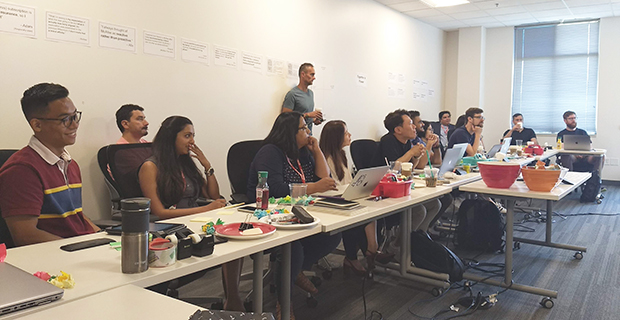
Step 2. Choose something new, old, used, and blue
In many western cultures, it’s a tradition for the bride to wear something new, something old, something used, and something blue on the wedding day. As it turns out, this is also a great way to think about defining design principles.
When we gathered everyone together, we instructed each of them to write their own design principles. They needed to come up with a minimum of four principles (maximum six if they were feeling ambitious). And if you hadn’t already guessed, the principles had to align with something new, old, used, and blue.
Here’s how it worked:

- Something new – Come up with a principle that you think can improve our product experience.
- Something old – Choose a current principle in the company (if available) that resonates with you — a core value, brand attribute, or principle practiced on your team.
- Something used – Borrow a principle from another company that resonates with you that you think can work for us.
- Something blue – Take something currently that makes you/ blue (sad or not enjoyable) about our products that you’d want to change. Then turn it around to convert it into a principle.
Here are some tips for making this work.
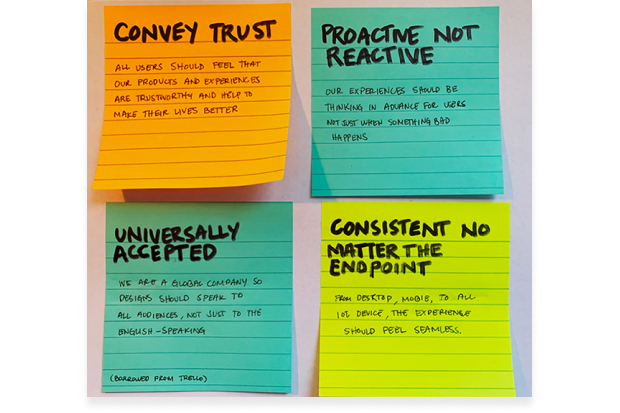
- Write each principle out on a post-it note. It should include a bolded title with supporting text underneath for how they feel the principle should be used. They can then be placed on letter-sized paper so that they can share later in groups.
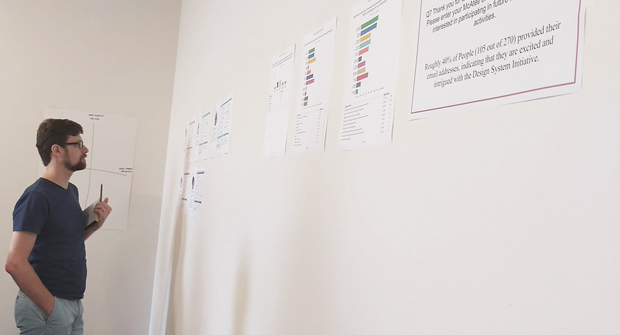 Here’s what it could look like once they’ve defined the principles.
Here’s what it could look like once they’ve defined the principles.- For those that need inspiration, decorate the room with elements that will help stimulate ideas. We posted things such as customer quotes, adjective cards, brand attributes, core values, and personas. We also provided links to the design principles of other brands.
Step 3. Assign your guests to groups
Most weddings included a dinner, which means you’ll need to assign your guests to tables. Pairing the right people at tables can be a bit like a match-making game – the goal is to always make sure that each table has excellent chemistry throughout the dinner.
This isn’t that much different than our next step in the design principle process, the group discussion. For this, it makes sense to arrange your participants in groups of 4 to 6 people – making sure you have a good mix of people from different backgrounds. Each group will then share their principles and talk through their decisions.
Here are some tips for making this work:
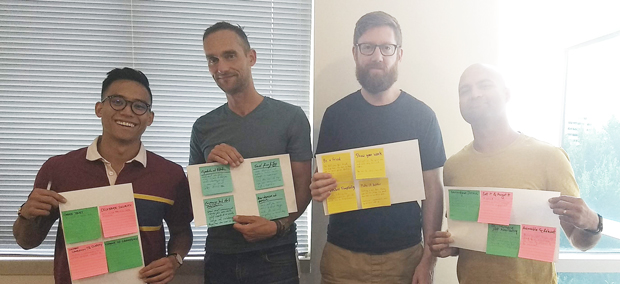
- It’s easy to share your principles holding the letter-sized paper.
- Once everyone has shared, the group will gather common themes and rank, as a group, the principles they want to keep – commonly known as affinity diagraming In the end, each group can only have 4-5 principles.
- You can give each group some tools to aid the process, like a prioritization matrix and voting dots.
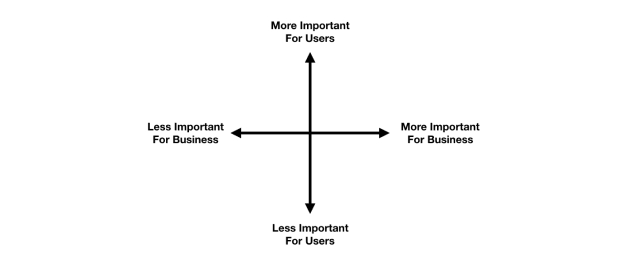 A prioritization matrix can help with choosing the right principles. If the principle is good for business and customers, then it’s probably a keeper.
A prioritization matrix can help with choosing the right principles. If the principle is good for business and customers, then it’s probably a keeper.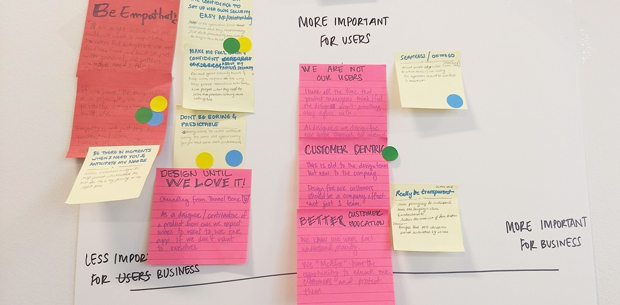 Dot voting is a great way to voice opinions anonymously without judgment.
Dot voting is a great way to voice opinions anonymously without judgment.This process can take up to 45 minutes, and, like any wedding dinner, it can get pretty loud. However, healthy discussion, negotiation, and teamwork are what this step is all about. When the time is up, you’ll have one representative from each team present their final principles to everyone.
Step 4: The ceremony
And this is where we come to the big day where all your planning is put to the test. Cue the Bridal Chorus as we approach the final step in defining your design principles.
After each group has presented their principles, it’s time to do one last round of clustering and comparing of principles to get everyone to come together and decide on your final 4 to 5 design principles.
This sounds daunting, but the good news is that you’ll start to see that a lot of the principles from each group are very similar. Your participants will likely want to prioritize the common principles. For any remaining, you can have everyone decide where they want to place them and why.
To help decide on these final principles, it’s a good idea to use the prioritization matrix or the dot voting you used before.
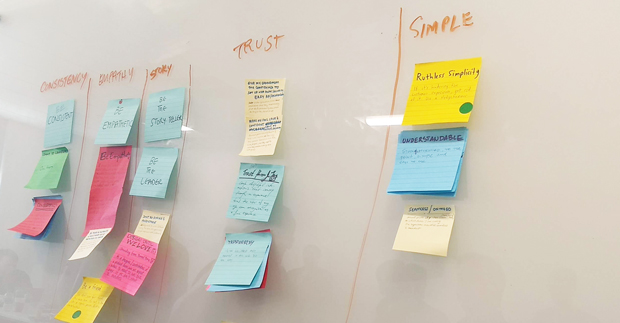 The final round in defining the principles for the design system. We decided on five principles we all agreed on.
The final round in defining the principles for the design system. We decided on five principles we all agreed on.When you’ve decided on your final principles, it’s fun to make a big deal out of it so everyone has a sense of accomplishment. And because I’ve used a wedding theme throughout this process, it only seems fair to keep it going to the end. Here’s a little something I used that really locked in the design principles we chose:
Is there anyone present that knows of any reason that these principles should not be applied to the product creation process? Speak now or forever hold your peace. Anyone object?
By the power vested in me by _company name_ and from the _team name_, I now present to you all, your design principles!
You may now high-five the person next to you!
It sounds corny, but a touch of novelty can go a long way.
Step 5. Everyone lives happily ever after
So you’ve had your ceremony and dinner and the guests watch as the happy couple leaves for their new life together. What happens now?
Well, this is a great time to put these design principles to the test. For us, it meant breaking into teams and participating in some “blue sky” re-designing of some aspects of our products using these new principles. At the end of the session, we had each group present their final projects and show everyone how they applied the design principles. The results were stunning!
Here are some samples from the final presentations. Each team reimagined a flow or product that needed some design love. They applied our five newly-defined design principles — Empathy, Trust, Simplicity, Consistency, and Story.
Anti-virus scan – Leveraging the principles Trust and Story, the team created a superhero-themed scan experience that could engage users in a whole new way.

Connecting devices – For this team, getting users to connect all their devices was done utilizing the principles of Simplicity, Trust, and Story.
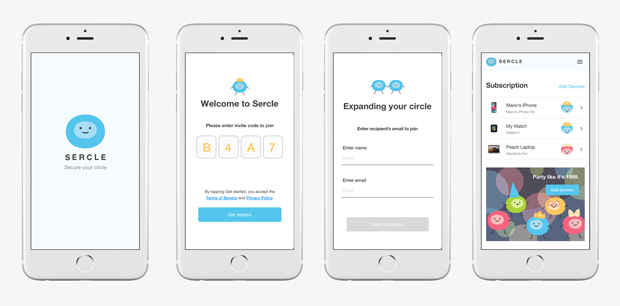
Consumer home page – Taking on the consumer home page was no easy task. The team employed the Empathy, Trust, and Consistency principles to guide their design choices.
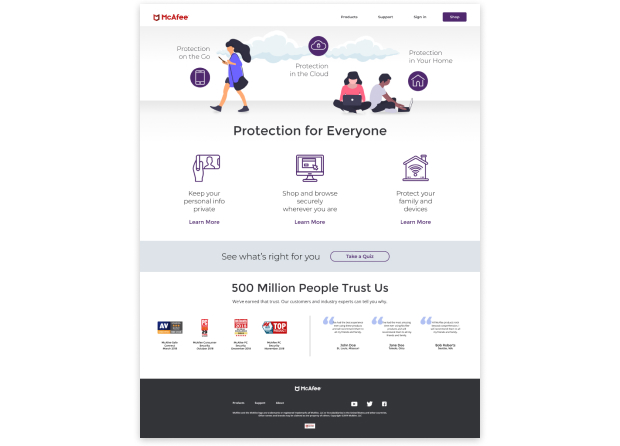
Once your team has gone through the process of defining your design principles, what moments will you look forward to? A better product experience? A crystal-clear company vision? A vibrant work culture?
Anything’s possible. The hope is that these principles help you navigate the future together as a team.
